Sporting and Law Enforcement Products - BP Corporation FY 1976
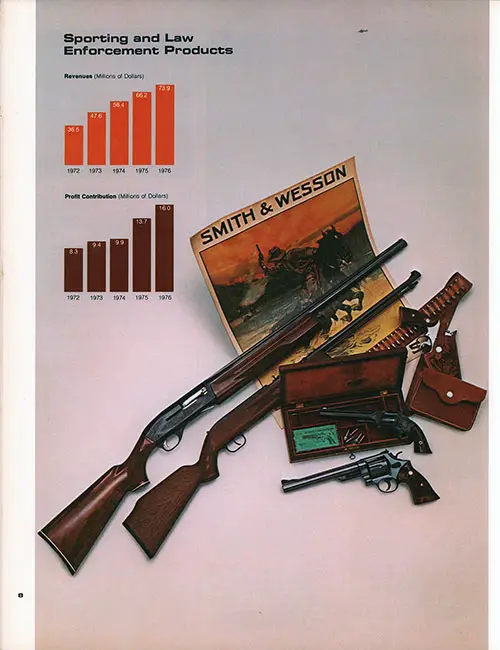
Sporting and Law Enforcement Products Division of the Bangor Punta Corporation Graphically Showing Revenues and Profit Contributions for Past Five Years. GGA Image ID # 15cd131694
Smith & Wesson, the principal company in the Sporting and Law Enforcement Group, was formed in 1852 as a partnership between Horace Smith and Daniel Baird Wesson for the development of a repeating handgun using a chamber-loaded projectile as opposed to previous muzzle-loading designs.
This first Smith & Wesson gun was nick-named the "Volcanic" because of its rapid-fire performance. In 1854, it was awarded a gold medal by the Maryland Institute of Mechanical Arts.
Since that time, Smith & Wesson has continued to pioneer revolutionary innovations in the firearms industry.
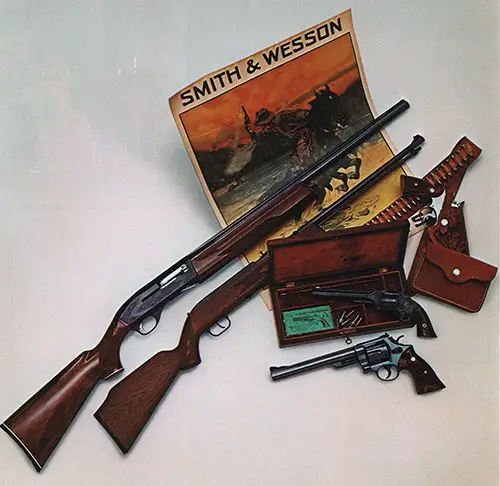
Smith & Wesson has pioneered in the development of quality firearms since 1852. GGA Image ID # 15cd910818
Horace Smith and D.B. Wesson moved from Connecticut to Springfield, Massachusetts, and in 1856 organized their company to manufacture a revolving pistol which would fire a small .22 caliber rim fire cartridge.
This new rim fire cartridge patented by the partners in 1854 was one of the most famous cartridges developed in the world. It was originally called the "Number One Cartridge" and it was fired in a new revolver called the "Model 1". It gained immediate popularity.
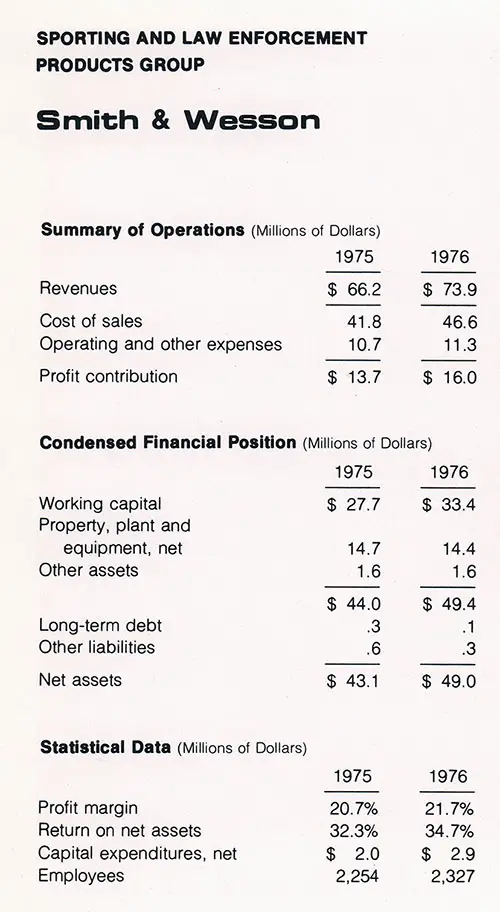
Sporting and Law Enforcement Products Group (Smith & Wesson) Summary of Operations, Condensed Financial Position, and Statistical Data for Fiscal Years 1975 and 1976. GGA Image ID # 15cd8231c5
Smith & Wesson Arms the Union
Arms produced for the Union forces in the Civil War firmly established Smith & Wesson as one of the leading firearms manufacturers in the United States. However, in the post-war depression Smith & Wesson, like many businesses, suffered severe business curtailments and sales dropped to only a few guns per month.
The partners realized that a new approach was necessary. In April 1867, they launched a new effort to establish markets in Europe. A display of Smith & Wesson arms at a major industrial exposition being held in Paris proved extremely popular and new orders from Europe began to relieve the effects of the domestic depression.
With business on the upswing, Smith & Wesson introduced their first large caliber 44 revolver called the Model 3. The Model 3 was a totally new design which incorporated a fully automatic ejection system and allowed rapid unloading and reloading of cartridges.
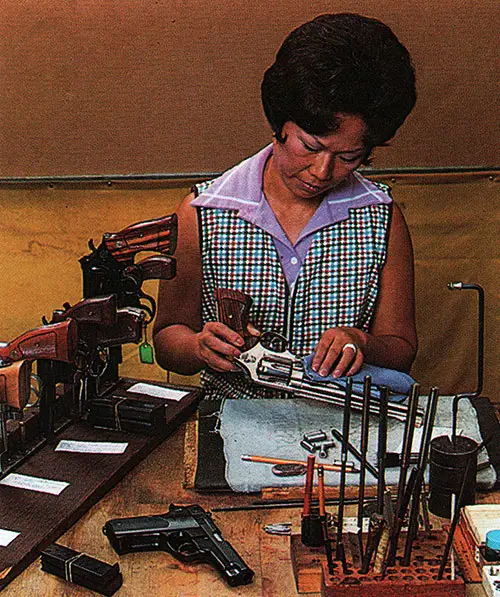
Each handgun receives a final inspection of more than 60 individual characteristics before it is ready for shipment. GGA Image ID # 15cd946fe3
New Firearms Designed
Smith & Wesson has continued to pioneer technological advancements over the years. In 1880 it produced the first double-action revolver. At the turn of the twentieth century, Smith & Wesson developed the .38 Special Military & Police revolver, which became the standard side-arm for law-enforcement agencies throughout the world and in the 1930's, introduced two more famous revolvers — the K-22 Outdoors- man for the competitive shooter and .357 Magnum for law enforcement officers.
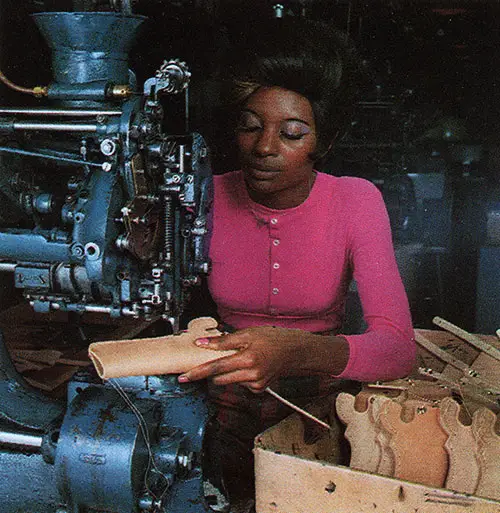
Smith & Wesson produces a broad line of top quality leather products which includes holsters, belts and cartridge cases. GGA Image ID # 15ce2f1c78
Leads in World War II Handguns
As it had done in World War I, Smith & Wesson answered the needs of World War M's allied fighting forces. By 1941 its total plant production was geared to supplying arms for the U.S. and her allies. In all, 1,300,000 units, or over 80% of the total revolver requirements for the Allied Forces were manufactured by Smith & Wesson during World War II.
In 1942, the company began to build new manufacturing and office facilities at its present Springfield, Massachusetts location. Construction was financed out of profits and completed in 1950.
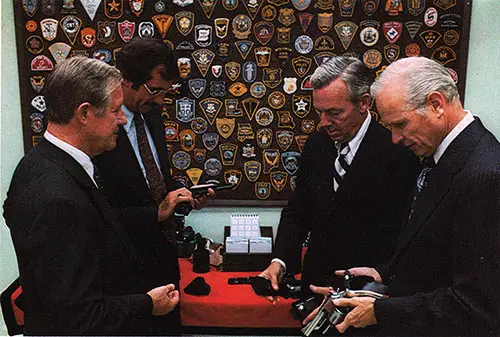
Smith & Wesson management (from left) James L. Oberg, President; Joseph L. Aurichio, Vice President - Finance; Richard H. McMahon, Vice President - Marketing; Lee J. Deters, Vice President - Manufacturing. GGA Image ID # 15ce7b13e4
Over the years, Smith & Wesson's reputation for quality, safety, and workmanship has established it as preeminent in the handgun market, a position which has been maintained to this day.
Bangor Punta Acquires Smith & Wesson
In 1965, when Smith & Wesson was acquired by Bangor Punta, the company was primarily a manufacturer of handguns and handcuffs. Thereafter, Smith & Wesson diversified its product base by acquiring Lake Erie Chemical Company — a manufacturer of tear gas munitions, General Ordnance Equipment Company — the originator and manufacturer of Chemical Mace non-lethal weapons, and Stephenson Corporation — manufacturer of Breathalyzer blood-alcohol analyzers.
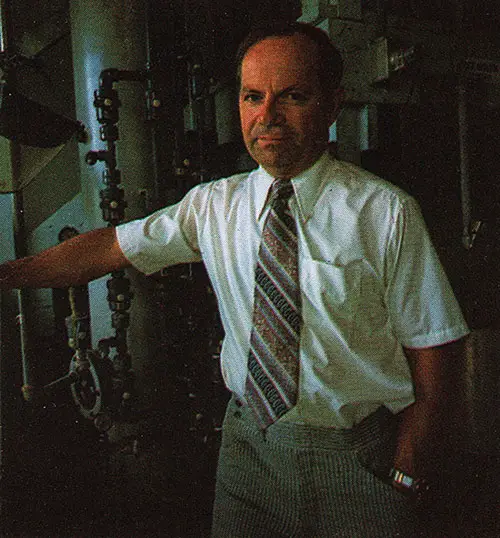
Keith B. Mullin, Vice President and General Manager, Smith & Wesson Chemical Company, Inc. GGA Image ID # 15cf6e84e5
Additional acquisitions enabled Smith & Wesson to manufacture leather products, ammunition, projectiles, and optical lenses, as well as the Identi-Kit identification system.
Star-Tron passive night vision equipment, a device which allows law officers to remain at a safe distance while conducting unobserved night surveillance, was developed within the Smith & Wesson group which has also expanded its product line to include the world's finest hunting knife, an automated version of the Breathalyzer evidence collection device, emergency pyrotechnic signaling devices and rocket-propelled line throwers.
Sales Grow at 20% Rate
Sales of the Smith & Wesson Group since 1966 have increased more than five-fold from $13 million to $72 million, an uninterrupted compounded sales growth rate of almost 20%. Over the last four years, Smith & Wesson continued its expansion into the international market, where sales have increased from $3 million to $13 million.
Smith & Wesson, in 1966, employed 1,000 people. Employment now totals 2,300 people. Many employees are skilled in various metal working trades which they passed from father to son and from generation to generation. Such skills have enabled Smith & Wesson to maintain its unique reputation for quality and craftsmanship.
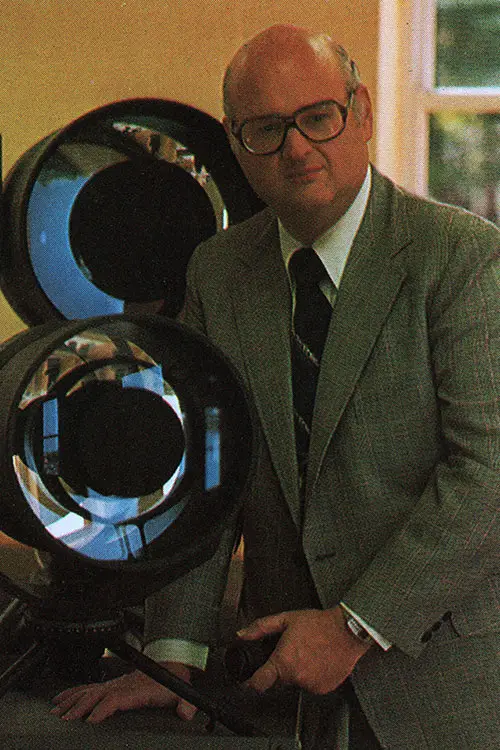
Alan Litman, Vice President - Research & Development, Smith & Wesson. Two second generation Star-Tron night vision models are pictured behind Mr. Litman. GGA Image ID # 15cfac9701
In fiscal 1976, the Sporting and Law Enforcement Products Group reported record sales and profits.
Police Products Lead
Despite curtailment of funds for law enforcement agencies, Smith & Wesson maintained its market position during 1976. Recently announced new versions of the world recognized Star-Tron line of night-vision equipment, personal protection equipment such as body armor and helmets, and new models of emergency vehicle warning equipment are an important element in the company's plans for future expansion in law enforcement and military markets.
Smith & Wesson also serves the law enforcement community through the operation of its Training Academy and Armorers School. These nationally known programs train police officers in the proper use and maintenance of Smith & Wesson equipment. Curriculum was expanded at the Academy in 1976 to meet more advanced police training needs.
New Sporting Products Introduced
Smith & Wesson's line of sporting products again in 1976 exceeded previous sales performance. A number of new sporting product introductions are planned, these include: Smith & Wesson's first BB gun — C02 powered, two further variations of the already well-received Model 1000 Autoloading shotgun; and a continuing flow of newly designed leather products to meet sportmen's demands.

Smith & Wesson's main manufacturing facility is located on 135 acres in Springfield, Massachusetts. GGA Image ID # 15cfe841f9
In order to satisfy increasing product demand, Smith & Wesson is planning a major expansion of facilities on land adjoining its principal operation in Springfield, Massachusetts.
This new expansion will provide space for the manufacture of sporting products, leather products and for a new customer service facility. During 1976, there was also an acceleration of capital expenditures for production facilities and equipment and a restructuring and expansion of the Research and Development staff and facilities at Smith & Wesson.

